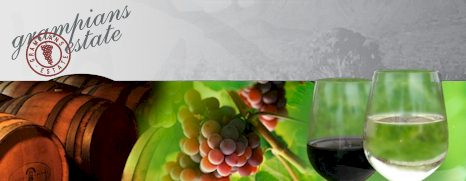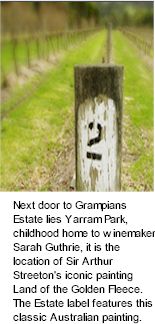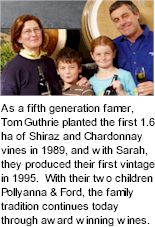


The Grampians Wine Region is one of the most significant, historical and acclaimed wine regions in the country. Vines were first planted at Bests and Seppelts in the mid 1860s and as they have prospered, others have joined them to produce wines of exceptional quality. The signature wines from the area revolve around the rich but delicate peppery shiraz wines, however white varieties such as riesling and chardonnay also suit the climate. And then there’s sparkling wines and the famous sparkling shiraz.

The climate and topography surrounding the Great Dividing Range, the soils and a commitment to sound vineyard and winery management are the ingredients to the unique wines produced in this region, wines which are being increasingly recognised by consumers and wine judges alike as top class and great value.
Like many rural families, the Guthries have a long history in sheep farming in Australia. Whilst diversification has led them to the establishment of a winery, they are carrying on a family tradition of continuous involvement in the sheep industry in Australia, which started by Tom’s great grandfather in 1847 when he emigrated from Scotland as a fourteen year old and began life as a jackeroo on a Tasmanian sheep station.
As a fifth generation famer, Tom Guthrie planted the first 1.6 ha of Shiraz and Chardonnay vines in 1989, and with Sarah, they produced their first vintage in 1995. With their two children Pollyanna & Ford, the family tradition of producing premium estate grown wines was established and continues today with award winning wines and vintages.

Situated twenty-three kilometres southwest of Moyston, or thirty-seven kilometres southwest of Ararat in western Victoria, the vineyard soils are composed of granite sands over sandstone. The local microclime is quite cool and slow ripening, with approximately twenty-eight inches of annual rainfall in a normal year. The vineyard is cane pruned, and the vines are all hand-picked. The yield of grapes is quite meagre at around two t/ac (1 to 3 t/ac) so the quality is always high, a scant production of approximately 1000 cases.
The Grampians Estate wine label is significant for a variety of reasons. It features the classic Australian painting Land of the Golden Fleece by Sir Arthur Streeton with Major Mitchell Plateau, the highest part of the Grampians apart from Mount William, overlooking a typical Australian landscape. Streeton, a member of the famous Heidelberg School of painters, referred to this 1926 painting as his greatest work.
"Thermopylae" the Guthrie family farm is within a short distance from "Yarram Park", this property was the location of the iconic painting "Land of the Golden Fleece" painted by Sir Arthur Streeton. As a child, Sarah grew up on this property with her father who was the Property Manager. The artists name and image features throughout the various vintages and is a strong reminder of Australian heritage and the land. The Grampians Estate vineyard is located on the north side of the Muirhead Range in front of the Plateau, whilst the painting itself was painted from Yarram Park, a neighbouring property where Sarah Guthrie grew up.
In the summer of 2006, the Grampians region was widely devastated by bushfires. Tom and Sarah’s property was one of those properties affected; over 90% of the vines were either burned or scorched. With the help of local and regional wineries, fruit was donated to continue the winemaking tradition. Today, the vines have been repaired and nurtured, and from the small 2007 vintage a return to estate grown wines commenced.
